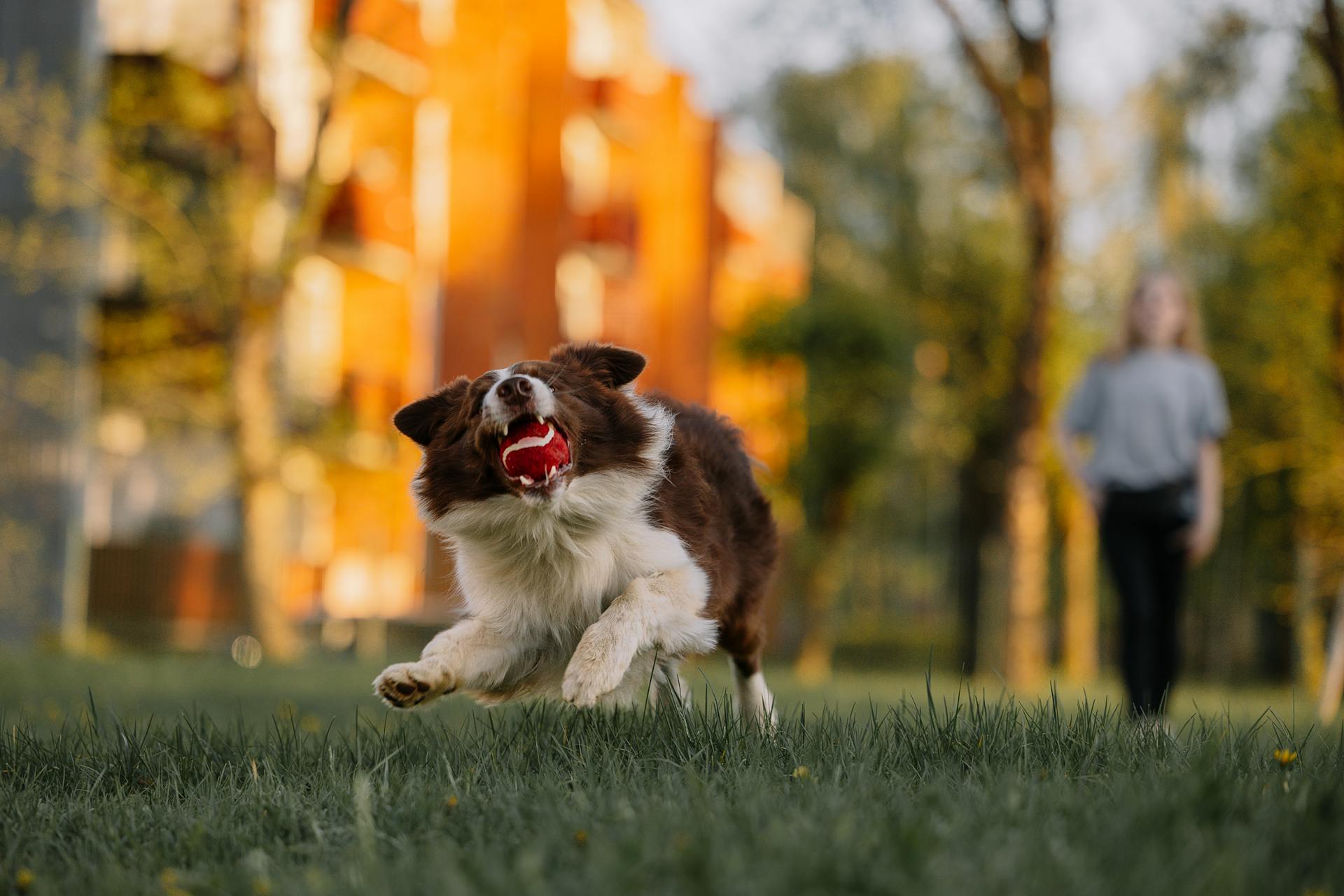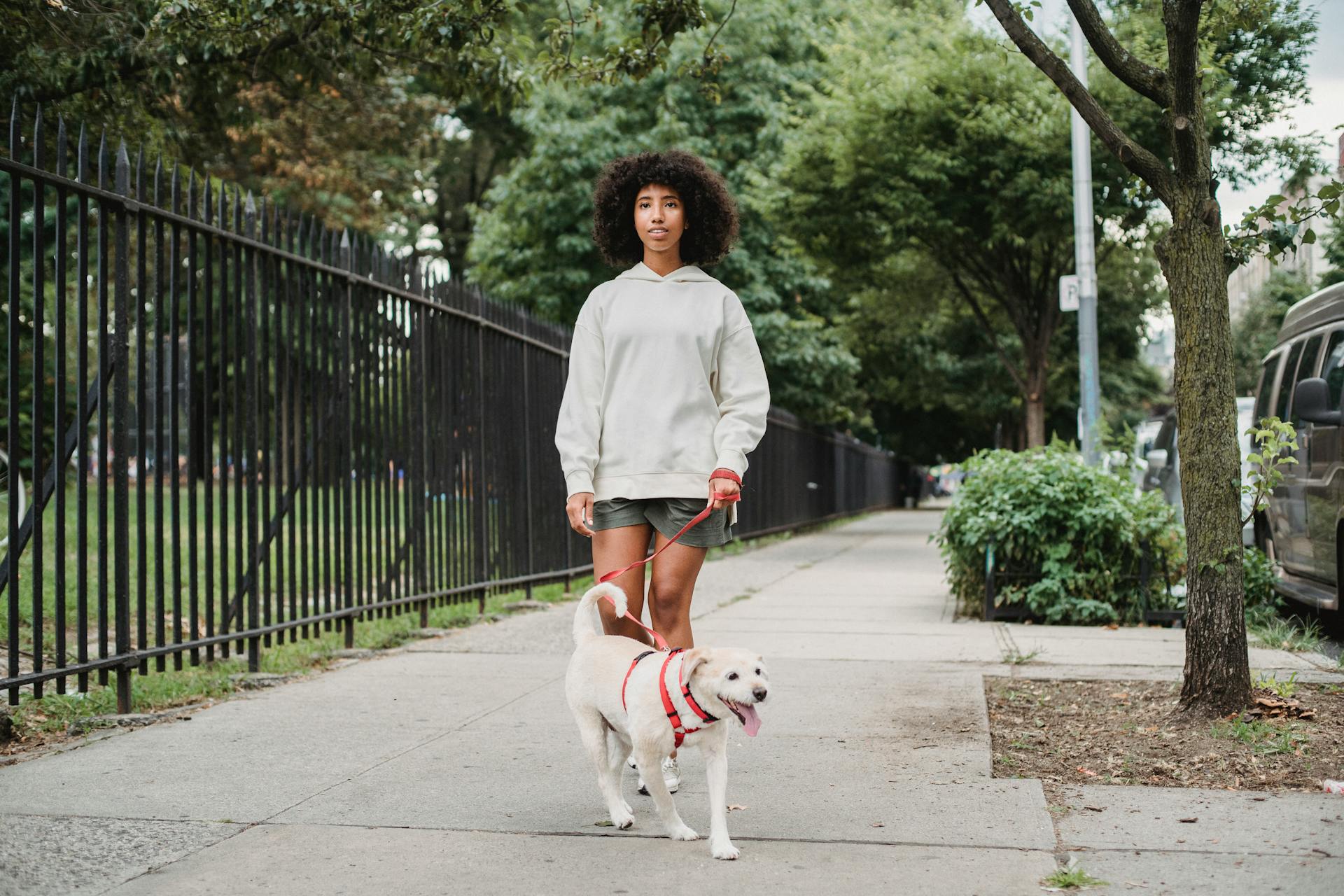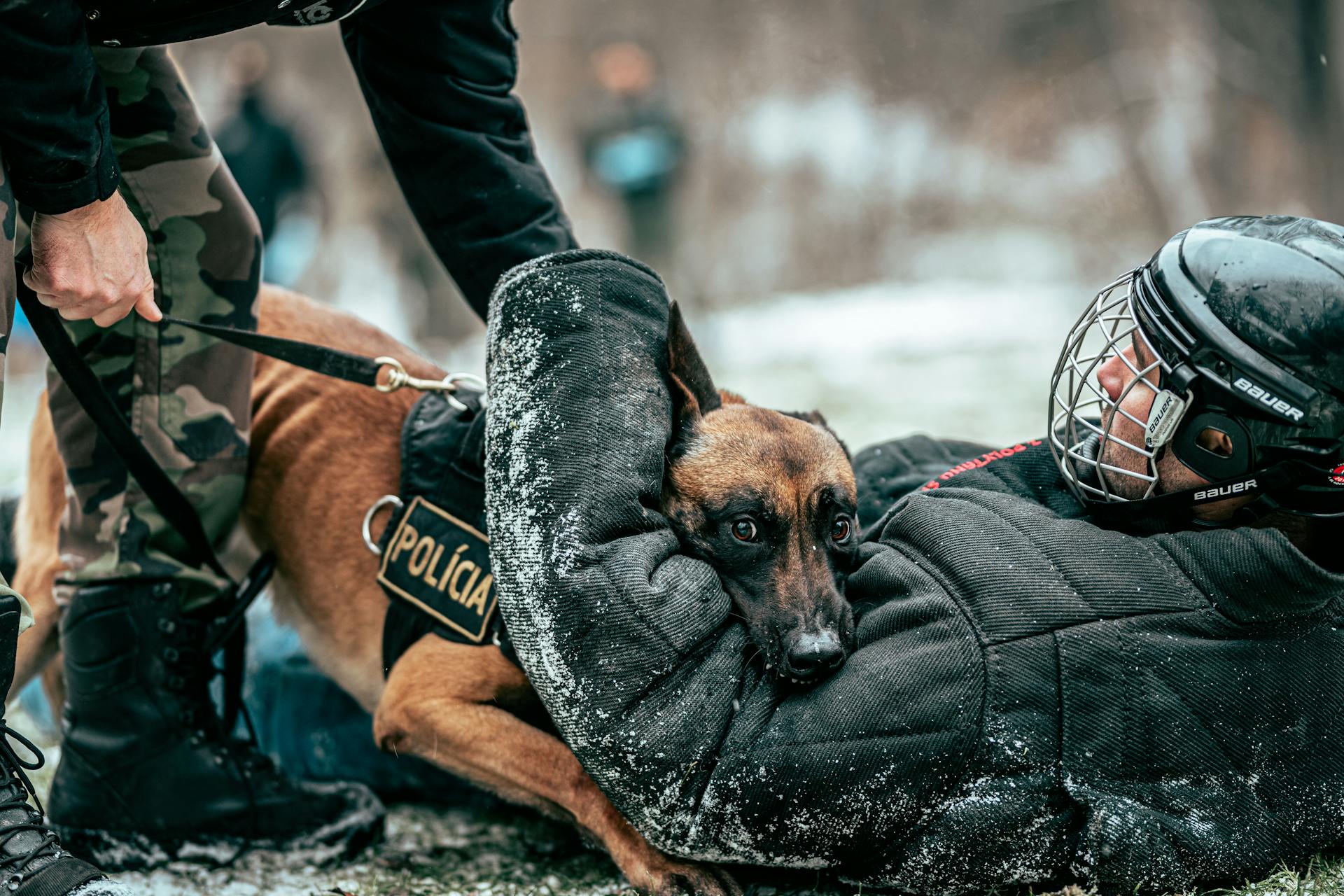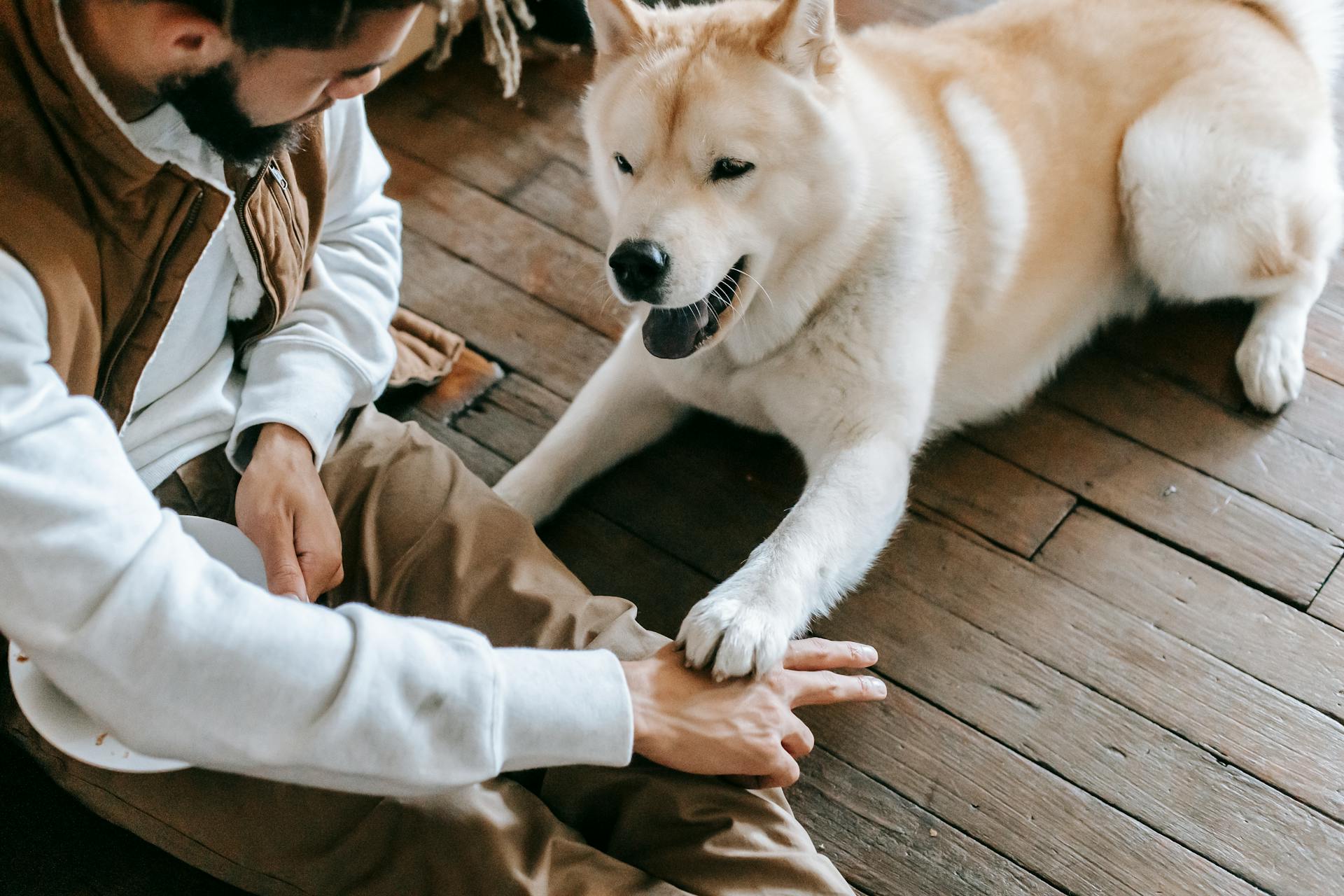
The main reason dogs run away is because they're not well-trained or lack proper exercise.
It's a common mistake to let your dog off lead in a public park without proper training, which can lead to them getting lost or injured.
A well-trained dog is more likely to respond to commands and stay by your side.
Preparation and Training
Start by preparing your dog for future emergencies, such as a shouted command not being understood as urgent but rather as angry. Practice training your dog to sit reliably in safe and controlled situations, like a fenced yard with other dogs.
To train your dog to walk off-leash, it's essential to understand that dogs have a curious nature, making it difficult for them to focus on your commands. Be patient and find ways to get their attention.
Practice is key to teaching your dog good off-leash behavior. Have daily training sessions, making it fun by including the lessons in their regular playtime. The safest way to teach your dog is to practice at a dog park or other fenced place.
A different take: Dog Training Lead Leash
Rewarding your dog is one of the most effective ways to train them to walk without a lead. Use their favorite treats to motivate them, and praise them to let them know you're happy with their behavior.
Teach your dog basic commands like "sit", "stand", "stop", "down", "no", "yes", "come", "drop it", and "over here." These commands will help you with training your dog to walk without a lead.
To strike a balance in rewarding your dog, don't give them treats too frequently, as they may lose interest. Consider consulting an experienced dog trainer, such as Alpha Paws, if you're having trouble training your dog.
Start training your dog in a low-risk environment with little to no distractions. Begin indoors or in an enclosed area, like a fenced yard, where your dog can roam without risk of running away.
Introduce toys and controlled distractions to your dog's recall training, then gradually increase real-life distractions. Choose safe places with boundaries, away from roads, people, and other dogs.
Before letting your dog off-leash, ensure they have a perfect recall, are even-tempered, and show no signs of aggression towards other dogs, people, or wild animals.
Teach your dog essential behaviors like "leave it" or "off" to add to their safety when off-leash. This can be useful in situations where your dog finds something they shouldn't, like food or another animal.
Distance down or down on recall is another crucial behavior to teach your dog. Imagine your dog is across the street, and you need to recall them quickly. Teach them to down at a distance to save their life in an emergency.
Here are some essential training commands your dog should master before being allowed to roam off-leash:
- Strong recall
- Walk to heel
- Sit
- Stay
- Down
It's never too late to train your dog off-leash, even if you have a rescue dog or an older dog. With time and patience, your older dog will be roaming off-leash in no time.
Managing Behavior
Reinforcing good behavior is key to preventing your dog from running away when off-leash. As mentioned in Example 1, it's essential to instruct your dog to sit-stay before letting it off-leash, and reward it for coming back to you with a treat.
To avoid reinforcing unruly behavior, it's crucial to end the play session on a positive note. Instead of punishing your dog for not coming back immediately, try repeating the recall command "Come Here – Sit – Go Play" over and over throughout the play session, as suggested in Example 1.
A reliable recall is essential for off-leash training, and teaching your dog to stay close to you is vital for their safety. You can use praise and treats to help your dog learn to stay close, as mentioned in Example 2.
Here are some common tendencies that may put a dog at risk for danger when they're off-leash, as listed in Example 6:
- Car Chasers: can be hit by cars or cause an accident by running behind a vehicle.
- Squirrel Chasers: often chase other small animals such as cats and rabbits.
- Noise-Phobic: dogs are typically afraid of fireworks, thunder, a car backfiring, and any sudden, loud sounds, provoking them to run out of fright.
- Hyperactive or Reactive: dogs either get too excited or show aggression when other animals are near and can get into fights with them.
- Wanderlust: pups mostly want to explore and may run away, completely ignoring your instructions and actions.
It's essential to understand your dog's limits and anticipate potential problems. As mentioned in Example 7, some dogs may have special fears or drives that can lead them astray. By being aware of these limitations, you can take steps to prevent your dog from running away when off-leash.
How to Manage Unruly Behavior
Managing unruly behavior in dogs can be a challenge, but it's essential to address the issue promptly. In fact, many dog owners unknowingly reinforce unruly behavior by letting their dogs off-leash to play and then leashing them again after they come when called.
This approach can be counterproductive, as it can create a sense of disappointment or punishment for the dog, leading to inhibited obedient responses. Instead, instruct your dog to sit-stay before letting them off-leash, and reward them with playtime when they come when called.
A reliable recall is essential for off-leash training, and it's not just about teaching your dog to come when called. You need to integrate recalls into play sessions, so your dog learns that coming when called is not the end of the world or the end of playtime.
By giving your dog a name for the problem behavior, such as "Go Play", you can turn it into a reward for coming when called. Every time you interrupt the play session and request your dog to come, you can say "Go Play" and reward them for coming.
To keep your dog safe off-leash, it's crucial to teach them to stay close to you. Using praise and treats can help you achieve this. If your pup stays close and you can trust them to obey recall commands, you can be worry-free when they're off the leash.
Here are some tips to help you manage unruly behavior in your dog:
- Be prepared with a long leash and high-value treats to keep your dog focused on you.
- Reward your dog and praise them for coming to you, even if it takes a long time.
- Reward your dog when they come to "check in" with you, even if you haven't called them.
- Gradually build up distractions to help your dog improve their focus on you.
Remember, every dog has limits, and it's essential to understand what motivates your dog and anticipate potential problems. By being aware of your dog's limits, you can determine when and where to let them romp free.
Avoid Food "Lures"
Using food as a lure can actually make off-leash training more challenging. Relying on a visible food supply or toys will fail more often than not in novel off-leash environments.
If your dog sees what reward you're offering, he can weigh its value against other temptations, like chasing a squirrel. This can lead to a mental game of "dog biscuit or squirrel chase?" - and the squirrel will likely win.
To keep your dog engaged, make rewards for off-leash behaviors interesting, exciting, and unpredictable. I find it helpful to list my dog's favorite things, from food and toys to freedom and play, and rank them in order of preference.
For one of my dogs, a tennis ball tops the list, while for another, chicken chunks and chasing small animals are the top choices. Freedom to run and romp is a close second for both.
Reserve your dog's top rewards for off-leash training and mix them up to keep things exciting. This will keep your dog guessing and give you an edge in a stimulating environment like a dog park or beach.
Check this out: How to Keep Gnats Away from Dogs?
What to Do If a Child Runs Away
If a child runs away, even if they've been well-behaved in the past, there's always a chance they might make a break for it.
Always be prepared for the unexpected and have a plan in place in case a child runs away. Even if your child has perfected their recall, there's always a chance they might run off, just like a dog that's learned to come when called.
On a similar theme: How to Catch a Horse That Runs Away?

Stay calm and act quickly to prevent further chaos. Even if your dog has perfected its recall, there’s always a chance that it might run off!
Check the immediate area and call out the child's name to see if they respond. If your dog starts to run away, don't chase after it, as this can lead to further excitement and a bigger problem.
Positive Reinforcement
Praising your dog on the way back to you is crucial for reliable recall. Praise the dog as soon as it starts to come back to you, and continue to praise it every step of the way.
Praising your dog on the way back to you is a way to reinforce good behavior. No matter how difficult this is to do, do it, as it will help your dog learn to come to you more reliably.
Rewarding your dog for coming back to you, even when it's slow and dejected, is essential for building trust. There is no point in getting angry at the dog; it was you, who made the mistake of letting an untrained dog off-leash.
Using treats to persuade your dog to come to you can be an effective way to build recall. Shake the packet and let your dog see it to grab its attention.
Rustling the packet can help grab your dog's attention and encourage it to come to you. By being considerate of your dog and mindful of others and your surroundings, you can make recall a fun and rewarding experience for both of you.
Safety and Emergencies
Preparing for future emergency situations is crucial, and one way to do this is by teaching your dog to "Sit" or "Come" when you shout. This way, your dog will understand that a shouted command conveys urgency and not anger.
It's essential to practice training your dog in safe and controlled, yet more distracting situations, such as when playing with other dogs in a fenced yard. This will help your dog develop the confidence to respond to your commands in any situation.
Teaching your dog the "Leave it" or "Off" behavior can be of great value in off-leash situations. This behavior can be used if your dog finds a tasty piece of garbage or wants to visit another dog.
Imagine your dog is across the street from you, and you need to get their attention quickly. Teaching your dog to down at a distance can save their life in an emergency.
Leash and Off-Leash
Training your dog to walk off-leash requires patience, consistency, and positive reinforcement. Start by establishing good behavior and ensuring your dog listens to your commands promptly.
Practice is key, so have daily training sessions to teach your dog the desired behavior when walking without a leash. Make it fun by including the lessons in their regular playtime, and the safest way to teach your dog is to practice at a dog park or other fenced place.
Use high-value treats to keep your dog interested and focused, and hold your leash loosely with your left hand. If your dog starts to move away, use a second treat to lure it back to its starting position before rewarding it again.
Broaden your view: Slip Lead Dog Leash How to Use
It's essential to teach your dog to stay close to you, using praise and treats to achieve this. A reliable recall is also crucial, so start by teaching your dog to come to you in a low-risk environment with little to no distractions.
Here are some steps to help you train your dog's recall:
- Use a long training lead and work in an area with little distractions.
- Start by commanding your dog to sit, then take a step away and use your "stay" command.
- Gradually extend your distance, repeating the steps over and over.
- Once your dog masters the technique, add distractions such as toys or movement.
- Repeat the steps by telling your dog to stay, then calling it to you using a clear command.
- Always reward your dog and give it lots of praise for coming to you.
Remember to keep your training sessions short and fun, and to introduce more distractions gradually to help your dog improve its focus on you.
Sources
- https://dogtime.com/dog-health/dog-behavior/1512-dog-training-behavior-not-coming-dunbar
- https://www.alphapaws.com/training-your-dog-to-walk-off-leash-properly/
- https://www.groomers-online.com/blog/2024/03/off-leash-dog-training/
- https://www.whole-dog-journal.com/training/building-off-leash-reliability/
- https://www.akc.org/expert-advice/training/dog-runs-after-taken-off-leash/
Featured Images: pexels.com


